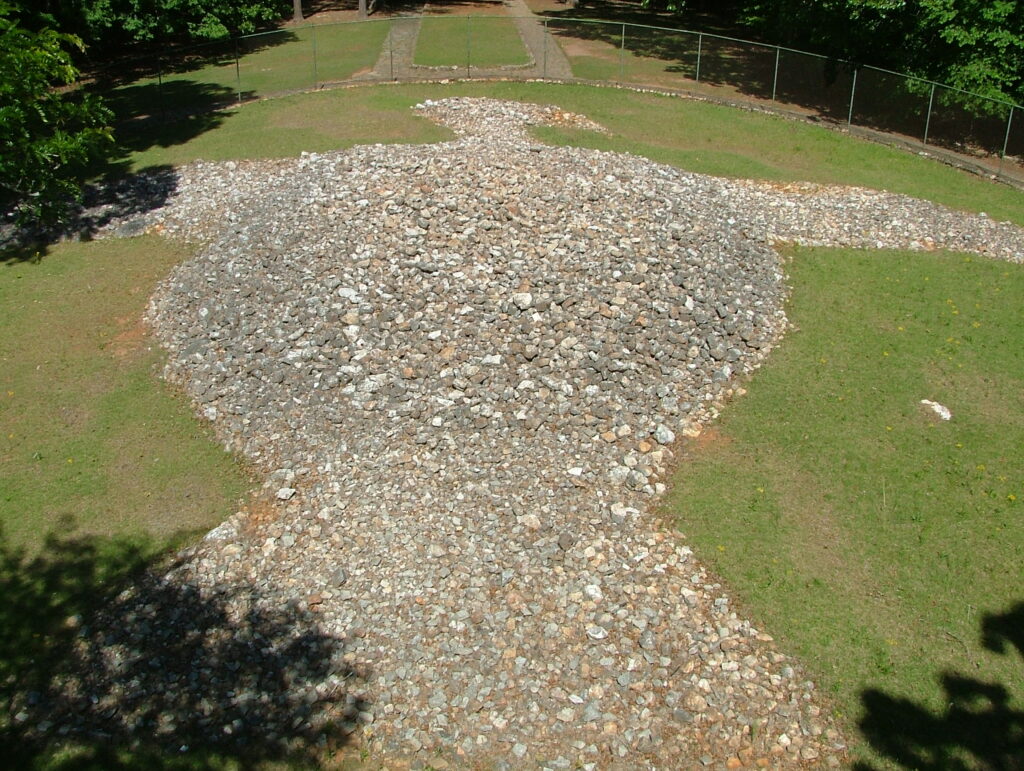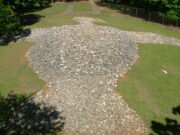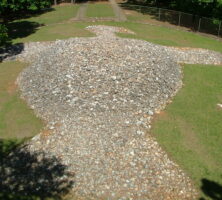Indian-made rock structures occur in several parts of Georgia. The most famous is the Rock Eagle just north of Eatonton in Putnam County. This large effigy, which measures 102 feet across the wings, is made of large quartz cobbles and likely dates to the Middle Woodland Period of the early centuries A.D. A second rock pile, which appears to be in the shape of a hawk, is located in eastern Putnam County. Several Indian-made rock walls surmount many of the high hills in central and northwest Georgia as well as adjacent central Tennessee. Such a wall once ringed the summit of Stone Mountain before it was destroyed in the Early Historic Period.

Photograph by Brian McInturff
Consensus among archaeologists is that all of these stone walls date back to the Middle Woodland Period. The function of these walled areas is generally thought to have been of a religious nature rather than a military fortification. The bird effigies are also thought to have had religious meaning. Small amounts of cremated human bone were found at the Rock Eagle site during excavations there in the early 1950s.
In addition to the rock structures built by Indians, there are thousands of small round (and occasionally square) piles of rock scattered throughout Georgia’s Piedmont. They also occur in South Carolina. The majority of these small piles are about ten feet in diameter and one to three feet high. A few larger piles exist, but these are much rarer. These man-made rock mounds occur singly, in small groups of 10 to 20, and occasionally in groups of more than 200. At the sites with many rock piles, a single, much larger pile frequently is included.
The origin of the small rock mounds has long been a controversial subject among archaeologists in Georgia. Certainly many of the mounds have been taken apart over the past 150 years, but they have almost never yielded either artifacts or other evidence that would permit them to be dated. A few of the larger stone mounds have yielded pottery and other items of the Middle Woodland Period. The small piles almost never have burial pits under them—the rocks were simply piled directly on the ground surface. Some archaeologists believe that the vast majority of these small piles were made when eighteenth- and nineteenth-century farmers plowed and cleared their fields, while other archaeologists believe many of them were made long ago by Indians, perhaps during the Middle Woodland Period when rock-moving activities seem to have been common.
There are legends among the Cherokee of the use of these rock piles as places for the burial of the dead. However, to date no such burials have been clearly documented. Chemical tests of the soil from under the mounds are ambiguous. There are often elevated levels of calcium and phosphorus, as would be expected if completely decayed human remains were present on the surface under the rocks. The rock piles attract large numbers of land snails, however, and when these die, the decayed remains of their shells add considerable calcium and phosphorus to the soil under the piles.
Whether specific small rock piles date to poorly understood Indian religious activities, or resulted from modern farmland clearing, these curious features of Georgia’s landscape should all be recorded for posterity and future research. One group of twenty-four small rock piles is preserved at the State Botanical Garden of Georgia in Athens, where they can be seen by the public.






